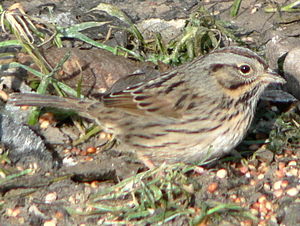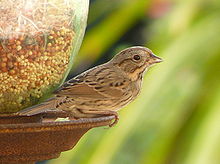Lincoln bunting
| Lincoln bunting | ||||||||||||
|---|---|---|---|---|---|---|---|---|---|---|---|---|

Lincoln bunting ( Melospiza lincolnii ) |
||||||||||||
| Systematics | ||||||||||||
|
||||||||||||
| Scientific name | ||||||||||||
| Melospiza lincolnii | ||||||||||||
| ( Audubon , 1834) |
The Lincoln bunting ( Melospiza lincolnii ) is a North American songbird that is found in Alaska, Canada, the northeastern United States, and the western United States. Its population is considered stable, and it is even common in large parts of its range. It is therefore classified as a non-endangered species.
Appearance
The Lincoln bunting has an olive-brown upper side with dark stripes, a light brown breast with fine dotted lines, a white belly and a white throat. It has a brown hood with white median stripes, olive-brown wings and a narrow tail. The face is gray with brown cheeks, eye stripes and an eye ring. The body length is 15 centimeters.
In their youthful dress worn only briefly, the young birds of the Lincoln bunting resemble the young birds of the swamp bunting , but they are generally paler than these. They differ from the young birds of the song bammer by their shorter tail and thinner beak. Adult Lincoln bunting show similarities with Passerculus sandvicensis , but this same-sized nurse species is mostly in the open and also flies up higher when it is startled.
Way of life
Food includes insects and seeds that are sought on the ground or in dense vegetation. They prefer to stay there. Frightened birds only fly up briefly and land with a characteristic rocking of their tails. Excited birds often put the little bonnet on their heads.
The Lincoln bunting breeds in bushes in wetlands in Canada , Alaska, and the northeast and western parts of the United States . They overwinter south of their breeding area and migrate to Central America. They then prefer to stay in thickets and overgrown fields. They migrate in spring from March to mid-May and in autumn from September to November.
The flat, open shell nest is built well hidden on the ground under bushes.
In the cold season, the bird migrates to the southern United States or Mexico and Central America.
Subspecies
A total of three subspecies are distinguished, which differ only in a few characteristics.
- Melospizia lincolnii lincolnii is the nominate form , which breeds in the northernmost range of the species.
- Melospizia lincolnii alticola is the largest subspecies and breeds in the mountains of western North America
- Melospizia lincolnii gracilis is the smallest subspecies and the darkest in color.
Trivia
The species is named not in honor of US President Abraham Lincoln . The bird species was named by the first descriptor John James Audubon in honor of his friend Thomas Lincoln from Dennysville, Maine. Lincoln shot a bird of this species during a short trip together to Nova Scotia in 1834. The species was first called Tom's Finch .
literature
- Jonathan Alderfer (Ed.): Complete Birds of North America , National Geographic, Washington DC 2006, ISBN 0-7922-4175-4 .
Web links
- Melospiza lincolnii in the endangered Red List species the IUCN 2008. Posted by: BirdLife International, 2008. Accessed January 31 of 2009.
- Videos, photos and sound recordings of Melospiza lincolnii in the Internet Bird Collection


